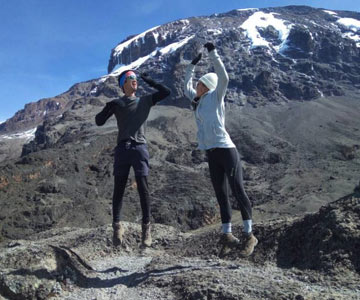Not all trails up Kilimanjaro are created equal. If you’re the kind of trekker who prefers peace over popularity, dramatic vistas over bustling campsites, and if you’re already comfortable with high altitudes, then the Shira Route could be your perfect match. Often mistaken as just a variation of the more popular Lemosho Route, Shira is one of the oldest and least-used trails on the mountain. While it shares much of the same route as Lemosho after the second day, the starting point is much higher, which completely changes the experience, especially on Day 1.
The Shira Route starts from the western side of Mount Kilimanjaro and follows a path similar to the Lemosho Route. However, the main difference is where you begin: Shira starts at Shira Gate, located at around 3,400 meters (11,155 ft), meaning you’re beginning your hike at a high altitude, without the gradual acclimatization that comes with starting lower in the rainforest zone like other routes.
Because of this, Shira is best for experienced hikers or anyone who has already spent time acclimatizing in Tanzania or another high-altitude region. It’s a trail that rewards you with immediate open skies, panoramic views, and a true sense of wilderness, but it also poses a higher risk of altitude sickness from the get-go.

Because the Shira Route begins high, it demands respect from Day 1. Altitude sickness can hit fast, especially if you haven’t already spent time at elevation.
Hydrate before and during the climb (3–4 liters per day)
Take it slow and steady pole pole is more than a saying; it’s survival
Consider spending a couple of days in Arusha or the Ngorongoro Highlands before the trek to pre-acclimate
Talk to your doctor about Diamox if you’re concerned about altitude
Monitor symptoms and be honest with your guide
Summit success isn’t just about fitness it’s about how well your body responds to thin air.
Because you’re starting high, nights can be colder right from the beginning, so gear up accordingly. Here’s what you’ll need:
High-quality, 4-season sleeping bag (rated to -10°C or colder)
Down jacket and thermal base layers
Waterproof and windproof shell jacket
Headlamp + extra batteries
Trekking poles (crucial for summit night and descents)
Sun protection (hat, sunglasses, sunscreen UV hits hard up there)
Hydration bladder and bottles (3L minimum)
Energy snacks and electrolyte tablets
Don’t forget a good mental attitude; things change quickly on Kilimanjaro, and adaptability is your superpower up there.
Whether you are ready for Tanzania Safari Dream or Kilimanjaro Adventure or Beach Relaxation for a few days or a few weeks long, our experts will create an itinerary from scratch, fully tailored to your wishes. Want to visit a beautiful destination or start an adventure to reach the top, or relax in a paradise, we will make it happen.
Kilisa Tours | Copyright © 2025 | All Right Reserved | Web by SechaPX